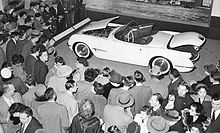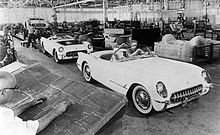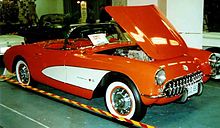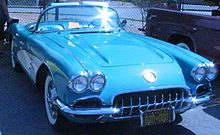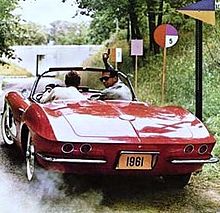- Chevrolet Corvette (C1)
-
This article is about the first generation Chevrolet Corvette (C1). For general Corvette information, see Chevrolet Corvette.
Chevrolet Corvette (C1) 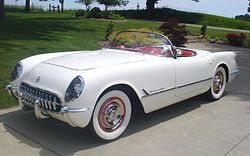
1953 Chevrolet Corvette ConvertibleManufacturer Chevrolet Division
of General MotorsProduction 1953–1962 Model years 1953–1962 Assembly Flint, Michigan United States (1953-early 1954)
St. Louis, Missouri, United States (early 1954-1962)Successor Chevrolet Corvette (C2) Class Sports car Body style 2-door convertible Layout FR layout Engine 235 cu in (3.9 L) 155hp Blue Flame[1] I6
(1953–1955)
265 cu in (4.3 L) Small-block V8
(1955–1956)
283 cu in (4.6 L) Small-block V8
(1957–1961)
283 cu in (4.6 L) Small-block FI V8
(1957–1961)
327 cu in (5.4 L) Small-block V8
(1962)
327 cu in (5.4 L) Small-block FI V8
(1962)Transmission 2-speed Powerglide auto.
3-speed manual (1955-1962)
4-speed manual (1957–1962)Wheelbase 102"[2] Length 167" The Chevrolet Corvette (C1) is the first generation of the sports car by the Chevrolet division of General Motors introduced late in the 1953 model year and produced through 1962. It is commonly referred to as the "solid-axle" generation, as the independent rear suspension didn't appear until the 1963 Sting Ray. The Corvette was rushed into production for its debut model year to capitalize on the enthusiastic public reaction to the concept vehicle, but expectations for the new model were largely unfulfilled.[3] Reviews were mixed and sales fell far short of expectations through the car's early years. The program was nearly canceled, but Chevrolet would ultimately stay the course and Harley Earl and company would transform the Corvette into a true world-class sports car.[4]
Contents
History
Origin 1951
In 1927 General Motors hired designer Harley Earl who loved sports cars. GIs returning after serving overseas in the years following World War II were bringing home MGs, Jaguars, Alfa Romeos, and the like.[5] In 1951, Nash Motors began selling an expensive two-seat sports car, the Nash-Healey, that was made in partnership with the Italian designer Pinin Farina and British auto engineer Donald Healey,[6] but there were few moderate-priced models.[7] Earl convinced GM that they needed to build a two-seat sports car, and with his Special Projects crew began working on the new car, "Project Opel" in late 1951.[7] The result was the hand-built, EX-122 pre-production Corvette prototype, which was first shown to the public at the 1953 GM Motorama at the Waldorf-Astoria in New York City on January 17, 1953. Production began six months later. The car is now located at the Kerbeck Corvette museum in Atlantic City and is believed to be the oldest Corvette in existence.[8]
Design and engineering
During the last half of 1953, 300 Corvettes were to large degree hand-built on a makeshift assembly line that was installed in an old truck plant in Flint, Michigan[3] while a factory was being prepped for a full-scale 1954 production run. The outer body was made out of then-revolutionary fiberglass material, selected in part because of quotas, left over from the war, limited the availability of steel. Underneath the new body material were standard components from Chevrolet's regular car line, including the "Blue Flame" inline six-cylinder engine, two-speed Powerglide automatic transmission, and drum brakes. The engine's output was increased however from a triple-carburetor system exclusive to the Corvette, but performance of the car was decidedly "lackluster".[9] Compared to the British and Italian sports cars of the day, the Corvette lacked a manual transmission and required more effort to bring to a stop, but like their British competition, such as Morgan, was not fitted with roll-up windows;[10] this would have to wait until sometime in the 1955 model year.[11] A Paxton centrifugal supercharger became available in 1954 as a dealer-installed option, greatly improving the Corvette's straight-line performance,[12] but sales continued to decline.
The Chevrolet division was GM's entry-level marque.[13] Managers at GM were seriously considering shelving the project,[14] leaving the Corvette to be little more than a footnote in automotive history, and would have done so if not for three important events. The first was the 1955 introduction of Chevrolet's first V8 engine since 1919. Late in the model year, the new 195 hp (145 kW)[11] 265 small-block became available with a three-speed manual transmission, coupled to a 3.55:1 axle ratio, the only one offered.[11] The engine was fitted with a single 2366S WCFB four-barrel (four-choke) Carter carburetor.[11] The combination turned the "rather anemic Corvette into a credible if not outstanding performer".[9] The second was the influence of a Russian émigré in GM's engineering department, Zora Arkus-Duntov. The third factor in the Corvette's survival was Ford's introduction of the 1955 two-seat Thunderbird,[15] which was billed as a "personal luxury car", not a sports car. Even so, the Ford-Chevrolet rivalry in those days demanded GM not appear to back down from the challenge. The original concept for the Corvette emblem incorporated an American flag into the design, but was changed well before production since associating the flag with a product was frowned upon.
1953–1955
The 1953 model year was not only the Corvette's first production year, but at 300 produced it was also the lowest-volume Corvette. The cars were essentially hand-built and techniques evolved during the production cycle, so that each 1953 Corvette is slightly different. All 1953 models had Polo White exteriors, red interiors[16], and black canvas soft tops. Order guides showed heaters and AM radios as optional, but all 1953 models were equipped with both. Over two-hundred 1953 Corvettes are known to exist today.[17] They had independent front suspension.[18]
The quality of the fiberglass body as well as its fit and finish was lacking.[3] Other problems, such as water leaks and doors that could open while the car was driven, were reported with the most severe errors corrected in subsequent units produced, but some shortcomings continued beyond the Corvette's inaugural year.[3] By December 1953, Chevrolet had a newly equipped factory in St. Louis ready to build 10,000 Corvettes annually. However, negative customer reaction in 1953 and early 1954 models caused sales to plummet.
In 1954, only 3,640 of this model were built and nearly a third were unsold at year's end. New colors were available, but the six-cylinder engine and Powerglide automatic, the only engine and transmission available, were not what sports car enthusiasts expected. It is known that 1954 models were painted Pennant Blue, Sportsman Red, and Black, in addition to Polo White. All had red interiors except for those finished in Pennant Blue that had a beige interior. Order guides listed several options, but all options were "mandatory" and all 1954 Corvettes were equipped the same.[19]
Chevrolet debuted its small-block, 195hp V8 in 1955[20] and the engine found its way into the Corvette. At first 1955 V8 Corvettes continued with the mandatory-option Powerglide automatic transmission (as did the few 6-cylinder models built), but a new three-speed manual transmission came along later in the year for V8 models only. Exterior color choices were expanded to at least five, combined with at least four interior colors. Even soft-tops came in three colors and different materials. Despite all this, only 700 Corvettes 1955 Corvettes were built, making it second only to 1953 in scarcity. Very few six-cylinder 1955 models were built, and all documented examples are equipped with automatic transmissions. The "V" in the Corvette emblem was enlarged and gold colored, signifying the V8 engine under the hood and 12 volt electrical systems, while 6-cylinder models retained the 6-volt systems used in 1953-54.[19] Rare option estimate: Manual transmission (75).[17]
1956–1957
There was no doubt Chevrolet was in the sports car business with the release of the 1956 model. It featured a new body, a much better convertible top with power assist optional,[21] real glass roll up windows (also with optional power assist), and an optional hardtop. The 3-speed manual transmission was standard. The Powerglide automatic was optional. The six-cylinder engine was gone. The V8 remained at 265 cubic inches but power ranged from 210-hp to 240-hp.[22] The volume was 3,167, a low number by any contemporary standard and still less than 1954's 3,640, meaning this was the third lowest-volume model in Corvette history.[19] Rare options: RPO 449 special camshaft with the 240-hp engine (111), power windows (547).[23]
Visually the 1957 model was a near-twin to 1956. Engine displacement increased to 283 cu in (4.6 L), fuel injection became optional, and a 4-speed manual transmission was available after April 9, 1957.[24] Fuel injection first saw regular use on a gasoline engine two years prior on the Mercedes-Benz 300SL "gullwing" roadster. Although the Corvette's GM-Rochester injection used a constant flow system, as opposed to the diesel style nozzle metering system of the Mercedes', the Corvette's engine nevertheless produced about 290 hp (216 kW) (gross). This was underrated by Chevrolet's advertising agency for the 283 hp (211 kW) 283 small-block V8 one hp per in³ slogan, making it one of the first mass-produced engines in history to reach 1 hp/in³. Pushed toward high-performance and racing, principally by Zora Arkus-Duntov who had raced in Europe, 1957 Corvettes could be ordered ready-to-race with special options. Fuel injection was in short supply and 1,040 Corvettes with this option were sold.[19] Rare options: RPO 579E 283 hp (211 kW) engine (1-hp per cubic inch!) with fresh air/tach package (43), RPO 684 heavy-duty racing suspension (51), 15" x 5.5" wheels (51), power windows (379), 4-speed transmission (664).[23]
1958–1960
In an era of chrome and four headlamps, the Corvette succumbed to the look of the day. The 1958 model year and the four that followed all had the exposed four-headlamp treatment and prominent grills, but a faux-louvered hood and chrome trunk spears were unique to 1958. The interior and instruments were updated, including placing a tachometer directly in front of the driver. For the 1958 model only, an 8000 rpm tachometer was used rather than the 6000 and rpm units typical in 1955.[25] Optional engine choices included two with twin carburetors (including a 270 hp (200 kW) model with Carter 2613 and 2614 WCFB four-barrels)[26] and two with fuel injection. Power output for the highest rated fuel-injected engine was 290 hp (220 kW). Displacement remained 283 cu in (4.6 l). For the first time, seat belts were factory-installed rather than being dealer-installed as on previous models.[27] Rare options were RPO 684 heavy-duty brakes and suspension (144), RPO 579 250-hp engine (554), 15 by 5.5 in (38 by 14 cm) wheels (404).[17]
For the 1959 model, engines and horsepower ratings did not change. Interiors were revised slightly with different instrument graphics and the addition of a storage bin to the passenger side. A positive reverse lockout shifter with "T" handle was standard with 4-speed manual transmission. This was the only year a turquoise convertible top color could be ordered,[28] and all 24-gallon fuel tank models through 1962 could not be ordered with convertible tops due to inadequate space for the folding top mechanism.[19] Rare options: RPO 684 heavy-duty brakes and suspension (142), metallic brakes (333), 15 by 5.5 in (38 by 14 cm) wheels (214), power windows (547), power convertible top (661).[17]
Last features to appear in 1960 models included tailamps molded into the rear fenders and heavy grill teeth. New features include aluminum radiators, but only with 270-hp and 290-hp engines. Also for the first time, all fuel-injection engines required manual transmissions.[29] The 1960s Cascade Green was metallic, unique to the year and the rarest color at 140 made. Rare options: RPO 579 250-hp engine (100), RPO 687 heavy-duty brakes and suspension (119), 15 by 5.5 in (38 by 14 cm) wheels (246), power convertible top (512), power windows (544).[17]
1961–1962
Four taillights appeared on the 1961, a treatment that continues to this day. Engine displacement remained at 283 cubic inches, but power output increased for the two fuel-injected engines to 275-hp and 315-hp. Power ratings for the dual-four barrel engines did not change (245-hp and 270-hp) but this was the last year of their availability.[30] This was the last year for contrasting paint colors in cove areas, and the last two-tone Corvette of any type until 1978. Rare options: RPO 353 275-hp engine (118), RPO 687 heavy-duty brakes and steering (233), 15x5.5 wheels (357), power convertible top (442).[17]
The 1962 model year was the last Corvette with a solid-rear-axle suspension that was used from the beginning. With two new engines it was also the quickest. Engine displacement increased to 327 cubic inches, but dual 4-barrel carburetor engines were no longer available. Hydraulic valve lifters were used in the base 250-hp and optional 300-hp engines, solid lifters in the optional carbureted 340-hp and fuel-injected 360 hp (268 kW) versions. Rocker panel trim was seen for the first time, exposed headlights for the last, until 2005.[19] This was the last Corvette model to offer an optional power convertible top mechanism. Rare options: 24-gallon fuel tank (65), RPO 687 heavy-duty brakes and steering (246), power convertible top (350), 15x5.5 wheels (561).[17]
Production notes
Year Production Base Price Notes 1953 300 $3,498 First year production starts on June 30; polo white with red interior and black top is only color combination; Options standard until 1955 for the car were interior door handles; "clip in" side curtains were a substitute for roll-up windows 1954 3,640 $2,774 Production moves to St. Louis; blue, red, and black are added; beige top, longer exhaust pipes 1955 700 $2,774 Both straight-6 and 265 cu in (4.3 L) V8 engines produced; 3-speed manual transmission added late in the model year 1956 3,467 $2,900 New body with roll-up windows; V8-only; 3-speed manual transmission becomes standard equipment and Powerglide moved to option list 1957 6,339 $3,176 283 cu in (4.6 L) V8; Optional 4-speed manual and fuel injection added 1958 9,168 $3,591 Quad-headlight body and new interior. Fake-louvers on hood and chrome strips on trunk lid. Number of teeth in grille reduced from thirteen to nine. 1959 9,670 $3,875 First black interior and dash storage bin; only year with a turquoise top. Louvres and chrome strips from '58 removed. 1960 10,261 $3,872 Very minor changes to the interior: red and blue bars on the dash logo, vertical stitching on seats 1961 10,939 $3,934 New rear styling, bumpers, and round taillights. New fine-mesh grill. 1962 14,531 $4,038 327 cu in (5.4 L) V8 engine; last year with a trunk until 1998 and last year with exposed head lights until 2004. New black grill with chrome surround, chrome rocker panel moldings. Total 69,015 Engines
Engine Year Power 235 cu in (3.9 L) Blue Flame I6 1953–1954 150 hp (110 kW) 1955 155 hp (116 kW) 265 cu in (4.3 L) Small-block V8 1955 195 hp (145 kW) 1956 210 hp (160 kW) 1956 240 hp (180 kW) 283 cu in (4.6 L) Small-block V8 1957 220 hp (160 kW) 1958–1961 230 hp (170 kW) 1957–1961 245 hp (183 kW) 1957–1961 270 hp (200 kW) 283 cu in (4.6 L) Small-block FI V8 1957–1959 250 hp (190 kW) 1960–1961 275 hp (205 kW) 1957 283 hp (211 kW) 1958–1959 290 hp (220 kW) 1960–1961 315 hp (235 kW) 327 cu in (5.4 L) Small-block V8 1962 250 hp (190 kW) 1962 300 hp (220 kW) 1962 340 hp (250 kW) 327 cu in (5.4 L) Small-block FI V8 1962 360 hp (270 kW) Zora Arkus-Duntov
Although not a part of the original Corvette project, Zora Arkus-Duntov made available late in the 1955 model year the 265 cu in (4.3 L) engine with a three-speed manual transmission. Duntov improved the car's positioning and image and helped the car compete with the new V8- engined Ford Thunderbird, and turned the Corvette from decidedly "lackluster" into a "credible performer". In 1956 he became the director of high-performance vehicle design and development for Chevrolet helping him earn the nickname "Father of the Corvette."[31] I[32]
See also
References
- ^ http://www.oldcarbrochures.com/static/NA/Chevrolet_Corvette/1955_Chevrolet_Corvette/1955_Corvette_Brochure/1955%20Chevrolet%20Corvette-04.html
- ^ http://www.oldcarbrochures.com/static/NA/Chevrolet_Corvette/1953_Chevrolet_Corvette/1953_Corvette_Foldout/1953%20Chevrolet%20Corvette-in.html
- ^ a b c d Prince, Richard (2002). Corvette Buyers Guide, 1953-1967. MotorBooks/MBI Publishing. p. 1. ISBN 9780760310090. http://books.google.com/books?id=6fqyf5ceXucC&pg=PA1&dq=Corvette+rushed+into+production&ei=MQ2XS97CKqO4ywSihqWpCg&client=safari&cd=2#v=onepage&q=Corvette%20rushed%20into%20production&f=false. Retrieved 2010-03-09.
- ^ Corvette 50th Anniversary by the Editors of Consumer Guide
- ^ Leffingwell, Randy; Newhardt, David (2005). Mustang. MotorBooks/MBI Publishing Company. p. 13. ISBN 9780760321836. http://books.google.com/books?id=pUPV5FtEh-MC&pg=PA13&dq=Corvette++Nash&ei=jDDVSbWaK5rAM_yhofkB#PPA13,M1.
- ^ Adler, Dennis (2004). Fifties Flashback. MotorBooks/MBI Publishing Company. p. 145. ISBN 9780760319277. http://books.google.com/books?id=kexmjJbrA5oC&pg=PA145&dq=Corvette+Nash&lr=&ei=ejLVSb-_GpKKNc6XqOQC#PPA145,M1.
- ^ a b Leffingwell, Randy (2002). Corvette: America's Sports Car. MotorBooks/MBI Publishing. pp. 14–19. ISBN 9780760313527.
- ^ "EX122 Motorama Experimental Protocol". Kerbeck Corvette. http://www.kerbeck.com/kerbeck/kerbeck.nsf/Worlds_Oldest_Corvette. Retrieved 26 April 2009.
- ^ a b Prince, Richard (2002). Corvette Buyers Guide, 1953-1967. MotorBooks/MBI Publishing. p. 25. ISBN 9780760310090. http://books.google.com/books?id=6fqyf5ceXucC&printsec=frontcover#PPA25,M1. Retrieved 2010-10-22.
- ^ http://www.oldcarbrochures.com/static/NA/Chevrolet_Corvette/1953_Chevrolet_Corvette/1953_Corvette_Foldout/1953%20Chevrolet%20Corvette-out.html
- ^ a b c d Popular Hot Rodding Yearbook 1981, p.88.
- ^ Mueller, Mike (2003). Classic Corvette 30 Years. Crestline Imprints. p. 40. ISBN 9780760318065. http://books.google.com/books?id=jBtsVHSnt5gC&printsec=frontcover#PPA40,M1. Retrieved 2010-10-22.
- ^ Ries, Al (2005). Focus: The Future of Your Company Depends on It. HarperCollins. p. 204. ISBN 9780060799908.
- ^ Baker, Ronald J. (2006). Pricing on Purpose: creating and capturing value. John Wiley and Sons. p. 89. ISBN 9780471729808. http://books.google.com/books?id=Y6YYr3e_bAcC&pg=PA89&dq=Corvette+lackluster&lr=&ei=4TTVScPMJYj-NcqX6PAC#PPA89,M1. Retrieved 2010-10-22.
- ^ McLellan, Dave (2002). Corvette from the Inside. Bentley Publishers. p. 20. ISBN 9780837608594. http://books.google.com/books?id=WCN7CfWjhhoC&pg=PA94&dq. Retrieved 2010-10-22.
- ^ http://www.oldcarbrochures.com/static/NA/Chevrolet_Corvette/1953_Chevrolet_Corvette/1953_Corvette_Foldout/1953%20Chevrolet%20Corvette-out.html
- ^ a b c d e f g The Genuine Corvette Price Handbook-2002 edition
- ^ http://www.oldcarbrochures.com/static/NA/Chevrolet_Corvette/1955_Chevrolet_Corvette/1955_Corvette_Brochure/1955%20Chevrolet%20Corvette-04.html
- ^ a b c d e f Gunnel, John, ed (1987). The Standard Catalog of American Cars 1946-1975. Kraus Publications. ISBN 0-87341-096-3.
- ^ http://www.oldcarbrochures.com/static/NA/Chevrolet_Corvette/1955_Chevrolet_Corvette/1955_Corvette_Brochure/1955%20Chevrolet%20Corvette-04.html
- ^ http://www.oldcarbrochures.com/static/NA/Chevrolet_Corvette/1956_Chevrolet_Corvette/1956_Corvette_Brochure/1956%20Chevrolet%20Corvette-04.html
- ^ 1956 Corvette brochure
- ^ a b The Genuine Corvette Price Handbook-2002 edition (full citation and page numbers needed)
- ^ Chevrolet press release-4-9-57
- ^ Popular Hot Rodding Yearbook 1981, pp.88-9.
- ^ Popular Hot Rodding Yearbook 1981, p.89.
- ^ 1958 Corvette brochure
- ^ 1959 Corvette brochure
- ^ 1960 Corvette brochure
- ^ 1961 Corvette brochure
- ^ Mueller, Mike (2000). Corvette, 1968-1982. MotorBooks/MBI Publishing. p. 94. ISBN 9780760304181. http://books.google.com/books?id=WCN7CfWjhhoC&pg=PA94&dq.
- ^ Prince, Richard (2002). Corvette Buyers Guide, 1953-1967. MotorBooks/MBI Publishing. p. 25. ISBN 9780760310090. http://books.google.com/books?id=6fqyf5ceXucC&printsec=frontcover#PPA25,M1.
External links
- The Corvette Museum: Corvette Timeline
- "Corvettes at Le Mans: GM Shows off rare 1960 Documentary". GM Media Archives. http://blogs.insideline.com/straightline/2010/05/corvettes-at-le-mans-gm-shows-off-rare-1960-documentary.html. Retrieved 29 May 2010.
Type 1950s 1960s 1970s 0 1 2 3 4 5 6 7 8 9 0 1 2 3 4 5 6 7 8 9 0 1 2 3 4 5 6 7 8 9 Subcompact Vega Monza Chevette Compact Corvair Corvair Chevy II / Nova Nova Nova Nova Mid-size Chevelle / Malibu Chevelle / Malibu Malibu Monte Carlo Monte Carlo Monte Carlo Full-size Fleetline 150 150 Delray Styleline 210 210 Biscayne / Brookwood Deluxe Bel Air Bel Air Bel Air Bel Air Bel Air Bel Air Bel Air Beauville Impala Impala Impala Impala Impala Impala Nomad Nomad Caprice Caprice Caprice Sports Camaro Camaro Corvette Corvette Corvette Type 1950s 1960s 1970s 1980s 1990s 2000s 2010s 3 4 5 6 7 8 9 0 1 2 3 4 5 6 7 8 9 0 1 2 3 4 5 6 7 8 9 0 1 2 3 4 5 6 7 8 9 0 1 2 3 4 5 6 7 8 9 0 1 2 3 4 5 6 7 8 9 0 1 3-box coupe C2 C3 C5 Fastback coupe Col. Ed. C4 C5 C6 Convertible C1 C2 C3 C4 C5 C6 Performance Fuel Injection Big Block ZR-1 LT4 Z06 Z06 L84 Big Block LT1 ZR1 Motorsports: Grand Sport • GTP • C5-R • C6.R Categories:- Chevrolet Corvette
- 24 Hours of Le Mans race cars
Wikimedia Foundation. 2010.

